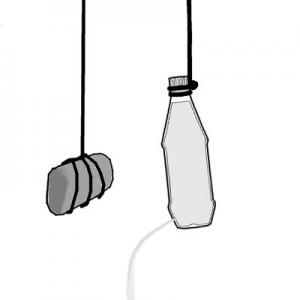Executive Summary
Hand washing with soap is the simplest way to prevent a variety of pathogens from entering our bodies and making us sick. Children living in households where hand washing with soap is promoted showed to have half the rates of diarrhoea compared to children in control groups. Simple hand washing devices can be made from readily available materials and manufactured with almost no costs. Hand washing requires access to clean water, soap and a social group willing to educate about the importance of hand washing and promote hand washing as an essential part of daily routines. The success of establishing hand-washing routines in a community vitally depends on how attractive the facilities are designed and constructed. The acceptance of hand washing is strikingly increased if facilities are conveniently located, clean and properly working.
Introduction
Adopted from WORLD BANK (2005)
Health issues are often closely related to hygiene practices and the management of water and sanitation (see Water Sanitation and Health). Hand washing can considerably contribute to an improved and sustainable sanitation system by interrupting the transmission of disease agents (see Health Risk Management). Consequently, diarrhoea, respiratory infections as well as skin infections and trachoma are significantly reduced. A recent review (CURTIS et al. 2000) suggests that hand washing with soap, particularly after contact with faeces (post-defecation and after handling a child’s stool), can reduce diarrhoeal incidence by 42-47 per cent. These results apply universally regardless of the level of sanitation faecal contamination. Another study recently found that children under 15 years applying hand washing with soap showed to have half the diarrhoeal rates compared to children living in neighbouring communities that do not apply hand washing (LUBY et al. 2004).
Because hand washing can prevent the transmission of a variety of pathogens. Promoted on a wide scale, hand washing with soap could be thought of as a ‘do-it-yourself vaccine’.
Hand Washing: The 'Do-it-yourself-Vaccine’
The most crucial component to encouraging hand washing is to make sure the hand-washing facilities are conveniently located, clean and properly working. Hand drying should also be taken into consideration. Carefully respect the habits of users when installing hand-washing facilities. The location (i.e. spot, height, etc.) of a hand sink depends on the users’ size (e.g. children or adults), the direction users are approaching the facility and their daily routines. Make sure that user comfort is ensured (e.g. install a drainage, establish frequent cleaning and maintenance, etc.). The more comfortable the facilities are, the more likely users continue to use them and the more they care and are willing to put effort into maintenance.
However, making the consequent use of hand-washing facilities an integral part of people’s daily routines involves more than just technical and practical installations and considerations. If the purpose and the benefits of hand washing are not fully understood by users, facilities are likely to be unaccepted, to be refused and to remain unused. Therefore, awareness raising has to be an integral part of any hand-washing promoting project.
Simple Hand Washing Container - A Container with a Hole in It
One of the simplest ways of making a hand sink is to find a container (e.g. a can or plastic bottle) and drill a hole in the bottom. After filled with water, hands can be washed while the water is slowly trickling down. This low-cost option is applied easily and very effective.
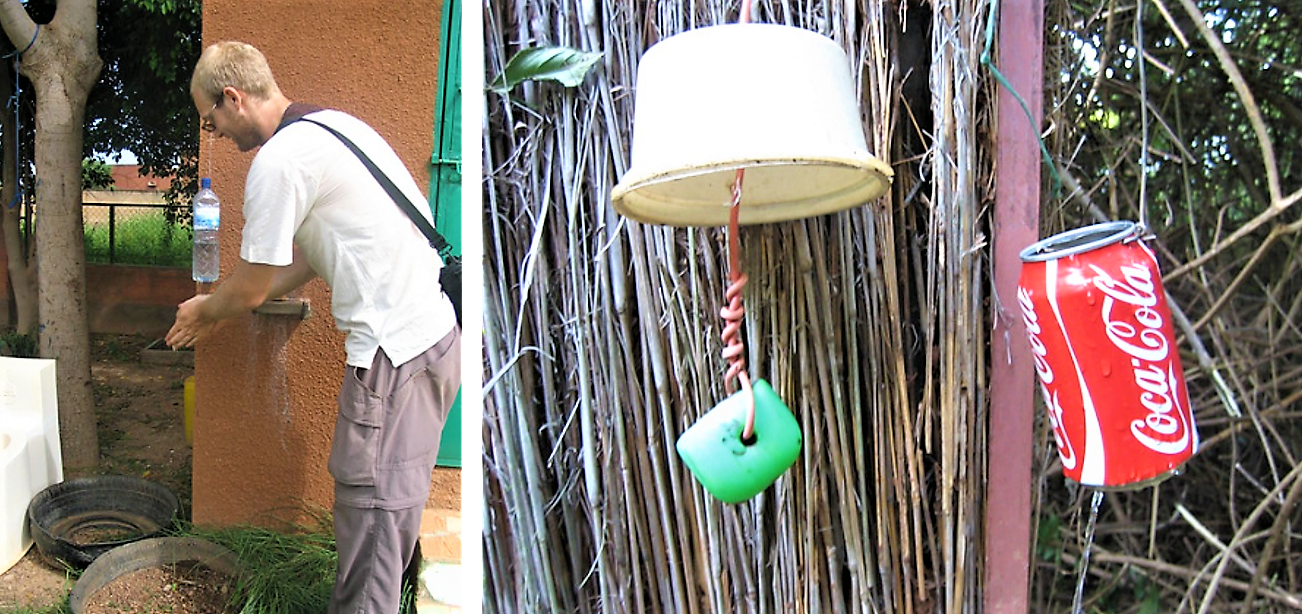
| Working Principle | Hand washing is only hygienic if water outlet is not contaminated during its use. Hanging up the container instead of putting it on the floor effectively avoids contamination of the outlet. |
| Capacity/Adequacy | The size of the container and the diameter of the hole determine the amount of water used per application. Since there is no switch to stop the water, the container requires refilling each time before use. |
| Performance | If just one hole is drilled, it is difficult to wash hands thoroughly. Drilling 4-5 holes allows to cover a greater area. |
| Costs | Often, containers and strings can be obtained free of charge. |
| Self-help compatibility | Can be built and repaired with locally available materials and amateur building experience. |
| Operation & Maintenance | Simple. Filling the container each time before use. Cleaning and check for proper working. |
| Reliability | High |
| Main Weakness | Requires refilling each time before each use (i.e. time consuming) Users get wet feet unless some kind of drainage is installed. |
| Main Strength | Cheap and easy to install |
| Applicability | Universally applicable |
‘Tippy Tap’ – Style Hand Sink
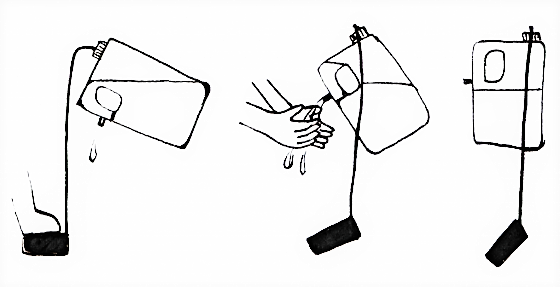
A tippy tap style hand sink can be made by several ways. The most common way is to find a container (i.e. a large can, bottle or pot) and drill a hole near the top. A string and a pedal are attached at the top of the container allowing the water to flow out.
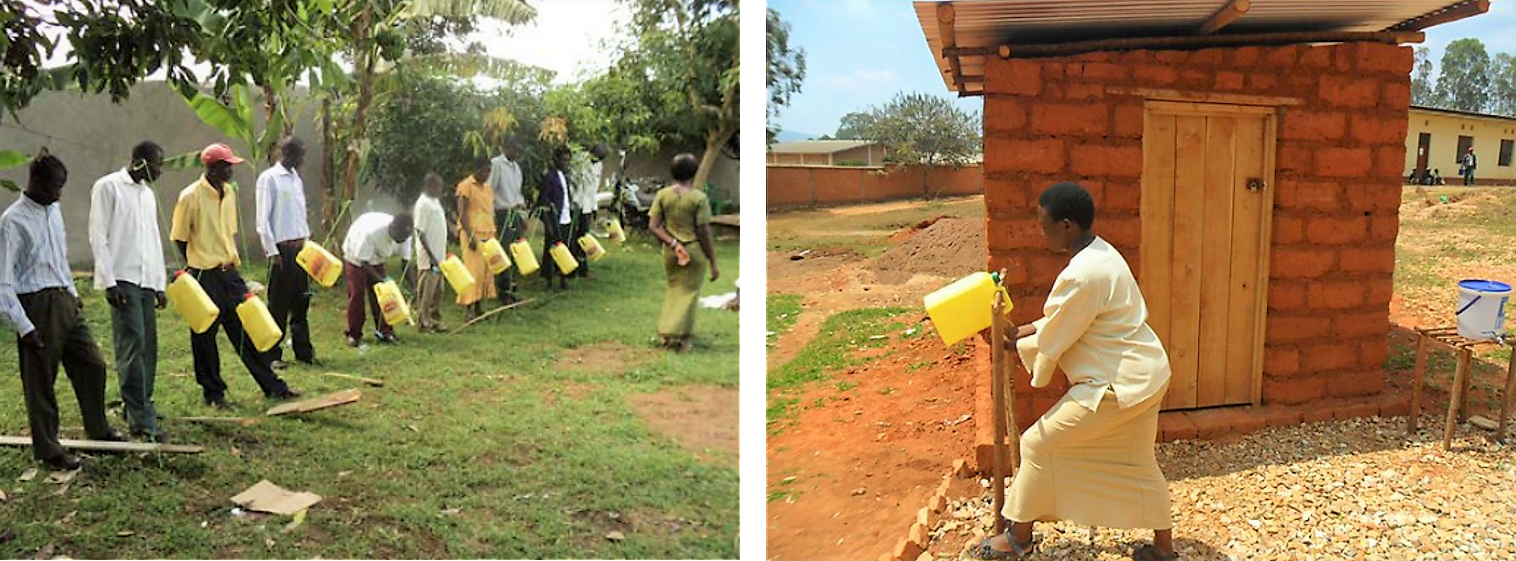
Further instructions on how to build a Tippy Tap can be found at Akvopedia.org (AKVOPEDIA 2008).
| Working Principle | Hand washing is more hygienic if users do not get in contact with the water outlet. Using a foot pedal to tilt the water container solves this problem. |
| Capacity/Adequacy | Capacity depends on the size of the container. Anything larger than 25 litres would be difficult to pull with the foot pedal. About 0.4 litres is used per application. |
| Performance | Adequately washes hands. |
| Costs | Very low. |
| Self-help compatibility | Can be built and repaired with locally available materials and amateur building experience. |
| Container can sway and pull depending on how the foot pedal is aligned. Care should be taken to set it up with sturdy support. | |
| Reliability | High |
| Main Strength | Easy to construct. Keeps water in a closed container making contamination unlikely to occur. Easy to use. |
| Main Weakness | Users get wet feet unless some kind of drainage is installed. The height cannot be adjusted. |
| Application | Universally applicable. The hand sink is useful for promoting hygiene in situations without running water. |
‘Tap Up’ Hand Sink- Simple but Requires Manufactured Fittings
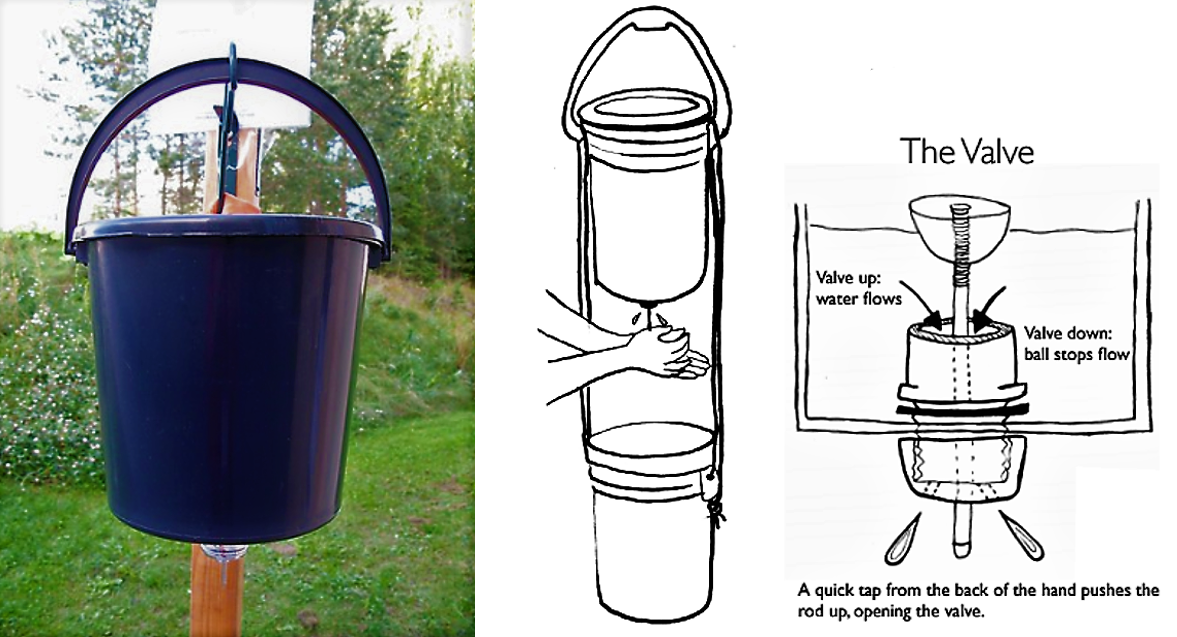
A bucket with a valve at the bottom can also serve as a hand sink. The ‘tap up’ hand sink was developed by Mathew Lippincott for outdoor festivals in the Pacific Northwest of the US in 2011. It is based on a Finnish design called the Andy Handy (see also under ‘important web links’ below).The Andy Handy costs about $40 USD and can be ordered from Finland. However, the ‘Tap Up’ sink can easily be constructed on one’s own.
Few details about the ‘Tap Up’ Hand Sink (5 gallons version) are given in the following table:
| Working Principle | Hand washing is only hygienic if water outlet is not contaminated during its use. The water outlet is continuously washed during usage and using either brass or copper valves prevent microbes from settling down. |
| Capacity/Adequacy | 5 gallons of water provides a minimum of 32 uses. Hand washing with the Tap Up requires about a half cup of water. |
| Performance | Four or more holes for the water spray allow for more effective hand washing. |
| Costs | $6 USD |
| Self-help compatibility | Can be built and repaired with locally available materials and amateur building experience. |
| Operation & Maintenance | The container needs frequent refilling. Leaks can be repaired by means of tape or other sealing material. |
| Reliability | High |
| Main Strength | Easy to construct. Easy to use. Economical water consumption. |
| Main Weakness | Requires a support structure (tree branch or building). |
| Applicability | The hand sink is useful for promoting hygiene in situations without running water. |
Applicable wherever running water is not an option for hand washing.
Review: Domestic hygiene and diarrhoea – pinpointing the problem
Planned, motivated and habitual hygiene behavior: an eleven country review
A review of strategies for encouraging hand washing with soap in developing countries.
CURTIS, V. ; DANQUAH, L. ; AUNGER, R. (2009): Planned, motivated and habitual hygiene behavior: an eleven country review. In: Health Education Research, March 13: URL [Accessed: 06.05.2019]Effect of Hand washing on Child Health: A Randomized Controlled Trial
Hand washing device using a can hand soap - Water is poured in to the tin can to trickles
Lesson on how to build a Tippy tap
Soda bottle hand-sink in Burkina Faso
A Tippy Tap next to a toilet facility
Diarrhoea: Why Children are still dying and what can be done
A 44-page report on the global impact of childhood diarrhoea and prevention strategies.
UNICEF ; WHO (2009): Diarrhoea: Why Children are still dying and what can be done. New York: UNICEF URL [Accessed: 15.05.2012]Hand washing Handbook: A guide to developing hygiene promotion program to increase hand washing with soap
Practical advice for starting a nationwide hand washing promotion campaign. Covers everything from financing the campaign to understanding the motivations of users.
WORLD BANK (2005): Hand washing Handbook: A guide to developing hygiene promotion program to increase hand washing with soap. Washington D.C.: World Bank URL [Accessed: 06.05.2019]Can hygiene be cool and fun?. Insights from school children in Senegal
This research project conducted among primary schools in Dakar suggests that relatively simple low-cost interventions can have far-reaching effects in improving children’s hygiene practices. They take into account motivational factors and children’s sensitivities in relation to toilet practice and personal hygiene.
SIDIBE, M. and CURTIS, V. WSP (2007): Can hygiene be cool and fun?. Insights from school children in Senegal. Nairobi (Kenya): Water and Sanitation Programme (WSP) URL [Accessed: 06.05.2019]Clean Hands for All: A toolkit for Hygiene Advocacy
This toolkit includes tools and resources to help hygiene advocates ensure that handwashing with soap is recognized as critical to health and development. It is designed to help users develop the ideas, tools, and messages to advocate to specific audiences to take action to promote and facilitate handwashing, to integrate handwashing messaging into existing advocacy campaigns and messages, and to engage others to advocate for handwashing.
GHP (2018): Clean Hands for All: A toolkit for Hygiene Advocacy. Global Handwashing Partnership (GHP) URL [Accessed: 06.05.2019] PDFDiarrhoea: Why Children are still dying and what can be done
A 44-page report on the global impact of childhood diarrhoea and prevention strategies.
UNICEF ; WHO (2009): Diarrhoea: Why Children are still dying and what can be done. New York: UNICEF URL [Accessed: 15.05.2012]Can hygiene be cool and fun?. Insights from school children in Senegal
This research project conducted among primary schools in Dakar suggests that relatively simple low-cost interventions can have far-reaching effects in improving children’s hygiene practices. They take into account motivational factors and children’s sensitivities in relation to toilet practice and personal hygiene.
SIDIBE, M. and CURTIS, V. WSP (2007): Can hygiene be cool and fun?. Insights from school children in Senegal. Nairobi (Kenya): Water and Sanitation Programme (WSP) URL [Accessed: 06.05.2019]Planned, motivated and habitual hygiene behavior: an eleven country review
A review of strategies for encouraging hand washing with soap in developing countries.
CURTIS, V. ; DANQUAH, L. ; AUNGER, R. (2009): Planned, motivated and habitual hygiene behavior: an eleven country review. In: Health Education Research, March 13: URL [Accessed: 06.05.2019]Hand Washing Devices. How to Make and Use
The information in this simple booklet has been accumulated over many years by the writer The school is perhaps the very best place with a special focus on promoting the importance of hand washing and teaching the simplest methods of making hand washers at schools.
MORGAN, P. (2011): Hand Washing Devices. How to Make and Use. Zimbabwe: Aquamor Pvt Ltd. URL [Accessed: 06.05.2019]How to Make Simple Hand Washing Devices
This presentation shows how hand washers can be made from tin cans and plastic bottles and cups. Hand washers of many types are easy to make and cost almost nothing. They should be fitted to every low cost (or high cost) toilet made.
SHANGWA, A. MORGAN, P. (2008): How to Make Simple Hand Washing Devices. Stockholm : Ecological Sanitation Research (EcoSanRes), Stockholm Environment Institute (SEI) URL [Accessed: 06.05.2019]Designing a Handwashing Station for Infrastructure-Restricted Communities in Bangladesh Using the Integrated Behavioural Model for Water, Sanitation and Hygiene Interventions (IBM-WASH)
In Bangladesh diarrhoeal disease and respiratory infections contribute significantly to morbidity and mortality. Handwashing with soap reduces the risk of infection; however, handwashing rates in infrastructure-restricted settings remain low. Handwashing stations - a dedicated, convenient location where both soap and water are available for handwashing - are associated with improved handwashing practices. The aim of this study was to identify a locally feasible and acceptable handwashing station that enabled frequent handwashing for two subsequent randomized trials testing the health effects of this behaviour.
HULLAND, K. ; LEONTSINI, E. ; DREIBELBIS, R. ; UNICOMB, L. ; AFROZ, A. ; DUTTA, N.C. ; NIZAME, F.A. ; LUBY, S.P. ; RAM, P.K. ; WINCH, P.J. (2013): Designing a Handwashing Station for Infrastructure-Restricted Communities in Bangladesh Using the Integrated Behavioural Model for Water, Sanitation and Hygiene Interventions (IBM-WASH). In: BMC Public Health: Volume 13 , 877. URL [Accessed: 30.09.2013]Healthy Schools, Healthy People: A cross-curricular, school-wide education program for middle schools
Activities, facts and slogans to use to motivate young teens to wash their hands with soap. Gives tips and advice on how to motivate school staff and students.
CDC ; AMERICAN CLEANING INSTITUTE (2003): Healthy Schools, Healthy People: A cross-curricular, school-wide education program for middle schools. Atlanta: Center for Disease Control and Prevention (CDC) URL [Accessed: 30.06.2019]How to build a tap up hand sink
An illustrated guide to building a bucket hand sink requiring a drill and plastic fittings.
DANIELSSON, M. LIPPINCOTT, M. (2012): How to build a tap up hand sink. URL [Accessed: 06.05.2019]Hand washing Handbook: A guide to developing hygiene promotion program to increase hand washing with soap
Practical advice for starting a nationwide hand washing promotion campaign. Covers everything from financing the campaign to understanding the motivations of users.
WORLD BANK (2005): Hand washing Handbook: A guide to developing hygiene promotion program to increase hand washing with soap. Washington D.C.: World Bank URL [Accessed: 06.05.2019]How to Make a Handwashing Bottle
This poster is part of the series of Water, Sanitation and Hygiene posters designed by the Water, Engineering and Development Center of Loughborough University.
REED, B. SHAW, R. CHATTERTON, K. (2013): How to Make a Handwashing Bottle. Poster. (= WEDC Posters , 8 ). London: Water, Engineering and Development Center (WEDC) URL [Accessed: 28.08.2013]Using Gourds for Handwashing
This poster is part of the series of Water, Sanitation and Hygiene posters designed by the Water, Engineering and Development Center of Loughborough University.
SHAW, R. (2013): Using Gourds for Handwashing. Poster. (= WEDC Posters , 9 ). London: Water, Engineering and Development Center (WEDC) URL [Accessed: 28.08.2013]Handwashing Promotion: Monitoring and Evaluation Module
This guide will walk you through planning and implementing monitoring and evaluation (M&E) for your handwashing promotion programme.
VUJCIC, J. RAM, P.K. (2013): Handwashing Promotion: Monitoring and Evaluation Module. New York: United Nations Children's Fund (UNICEF) URL [Accessed: 04.02.2014]Global Handwashing Partnership
An entire website dedicated to the importance of hand washing. The site is particularly interesting for the school context and also contains further reading materials.
MAKE YOUR OWN HAND WASHING MACHINE!
A webpage fully dedicated to the construction of self-made simple hand washing devices. Unfortunately, only in Finnish.
Handwashing Devices
This link contains videos introducing two simple hand-washing devices and how to use them.

